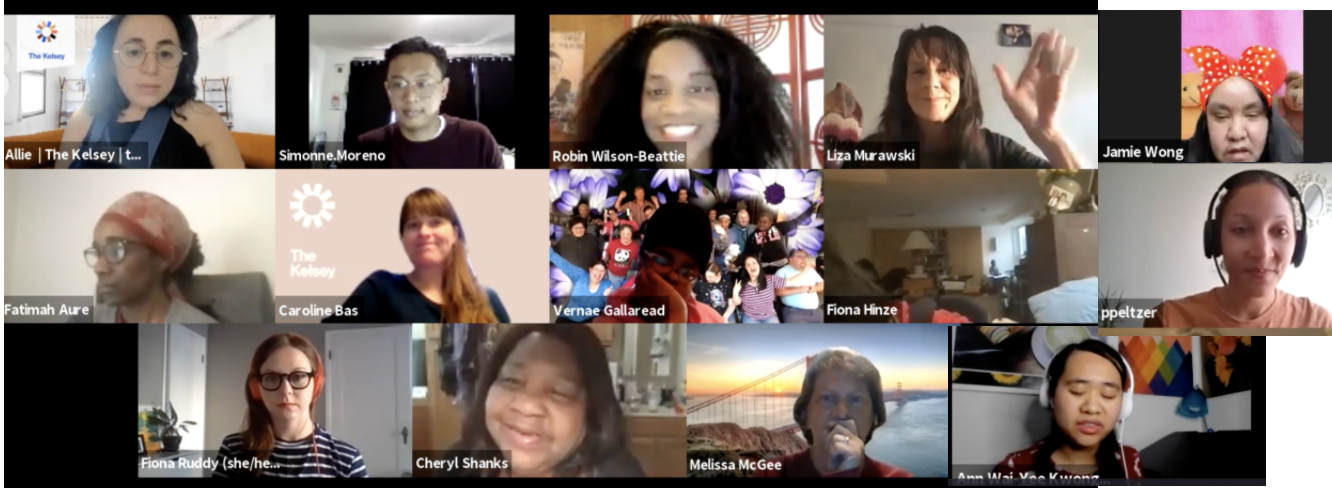This is part of a Building Inclusivity series, from a 2021 convening with national organizations working at the intersection of housing and disability.
Disability-forward housing solutions cannot be fully realized without co-leadership from people with and without disabilities, particularly those who are most proximate to the housing crisis – this includes Disabled people who are people of color, LGBTQIA, extremely to very low income, formerly unhoused and institutionalized and people who need supportive services. The oppression faced by people with disabilities underscores the importance of representation within your own organization.
To begin, a reflective exercise can be to rate your organization from 1-5 on its co-leadership across disabled and non-disabled people, and please include volunteers, advocates, paid consultants, staff, executives, and board members. 1 means no people with disabilities are regularly involved in your work. 5 means disabled people are in leadership positions and have the same or more decision-making power than non-disabled leaders. A score of 5 means that disabled leaders are visible and influential at every level of your organization. This might seem like an impossibly high bar. If your organization is not fully representative yet, that is alright. Note, the work of supporting disabled leadership and becoming a co-led organization is an ongoing, iterative process. Meaningful, diverse leadership is a journey, not a destination.
Supporting Disabled leadership within your organization should be an ongoing, core practice whether your inclusive housing organization is in the pre-development phase, seeking financing, or already operational. Ensuring diversity in leadership can never happen too early.
Here are some tips and practices for building inclusive leadership:
- Build authentic, reciprocal relationships with disability-led organizations and disabled leaders in your communities. There is a wide network of organizations, collectives, and individuals who are impacted and working directly or indirectly to address the housing crisis facing people with disabilities. To start, try contacting your local independent living center, peer-run mental health organizations, local self-advocacy groups, ADAPT chapter, Deaf and Hard of Hearing organizations, and Blind and Low Vision organizations, and other consumer-led organizations.
- Reimagine and practice new workplace and professional norms, such as flexibility for how meetings are run, how tasks and concepts are communicated and paced. For example, conduct an access check-in and have each person share what they may need in order to fully participate in the meeting. Also, less is more. Often having a packed agenda that moves quickly can leave people behind. Check out guides and tools about plain language, creating inclusive training, and more from Autistic Self Advocacy Network.
- At a minimum, provide the option for participants to request accommodations before events and programs. If it is a public event, the best practice is to ensure the location is wheelchair accessible, materials are accessible via a screen reader, and there are captioning and ASL interpreters already booked (regardless of whether accommodations have been requested). Regardless of the approach, be upfront on all promotional materials about what access will be provided and direct contact information people can use to inquire further. Learn more here and here.
- Establish a community advisory group or council comprised of prospective future residents and neighbors with and without disabilities that provide consistent feedback on all aspects of the development process that they can have a genuine influence on.
- If you are already operating inclusive housing, establish a resident leadership council that can enable residents with and without disabilities to inform and advise in the operations of the building as well as housing advocacy that influences their surrounding communities.
- Bring on people with disabilities, particularly Disabled people of color, as paid consultants, staff, and board members.
Centering your work on disabled leadership involves an important practice of paying disabled people for their work. It sounds simple, but an ugly truth about working to advance rights for disability communities is that people with disabilities are disproportionately underpaid or not paid for their work. Be aware of embedded ableism or “crip taxes” (or the hidden costs associated with living with a disability) in work expectations, where people with disabilities are assumed to provide insight or expertise for free, despite that work having value.
To counteract this notion, always provide financial compensation for the labor, advice, and perspectives of disabled leaders. Communicate the budget and payment schedule to these leaders from the start. Some work is full-time salaried positions and others are stipend or honorarium based. If there are certain opportunities that are strictly voluntary, name those differences in full transparency. Open, honest, and transparent communication can negate confusion around compensation.
Supporting and investing in Disabled leadership is a continuous process that is paramount to developing and operating inclusive housing. The housing field must go beyond tokenization of people with disabilities, and genuinely build out organizations that disabled people are co-leading. Wherever you may be starting from, all organizations can increase their expectations and practices for how Disabled people can lead and have decision-making power along with their non-disabled colleagues. Now is the time to reflect and determine how you can take proactive steps to center the perspectives, experiences, and leadership of people with disabilities.

